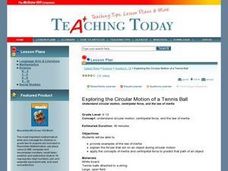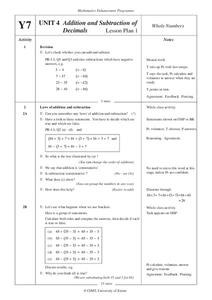Curated OER
Of Mice and Men by John Steinbeck
Here's an illustrated Of Mice and Men worksheet that asks readers to respond to five short answer prompts and complete 4 graphic organizers designed to be used prior to reading, while reading, and after reading Steinbeck's Of Mice and...
Curated OER
Canadian Landscapes
Ninth graders compare landscapes in their own community to landscapes in other Canadian communities. They discuss how the environment affects the identity of a given community / country.
Curated OER
Exploring War Themes in Art and Poetry
What is war? Students discuss the ethical dilemma of war by viewing Picasso's painting entitled "Guernica" and write down everything they see in the painting. Then they choose one emotion that best summarizes their emotional response to...
Curated OER
Seedfolks
Students explore sequencing. In this sequencing lesson, students sequence events to analyze character actions as cause and effect or the plot of the story. Students discuss character actions and list them on a chart.
Curated OER
Go, West, Pack Light!
Students investigate the hardships related to pioneer life and the Wagon Train. They listen to an excerpt from the book "Little House on the Prairie," and discuss the hardships faced by pioneers travelling west. In small groups...
Curated OER
Exploring the Circular Motion of a Tennis Ball
Students are introduced to the concept of circular motion. In groups, they participate in experiments to discover the law of inertia. They describe how forces act on objects during a circular motion. To end the lesson, they use these...
Curated OER
Exploring the Nervous System Through Disease and Injury
Students are introduced to the nervous system. In groups, they research the relationship between disease and injury and how it affects the nervous system. To end the lesson, they present their findings to the class and create a poster.
Curated OER
The Children's March
Learners watch the film, The Children's March. In this civil rights instructional activity, students view a video on the Civil Rights Movement in Montgomery Alabama. Learners then complete a worksheet that will prompt a classroom...
Curated OER
Once Upon A Time...
Students discuss elements of fairy tales, examine selected piece of Robert Harris' art, and compose fairy tales based on what they see and imagine. Students then view homes in Harris' artwork collection, create home in which they would...
Curated OER
World War I
Eighth graders examine the condition of the world from 1880 until the start of World War I. After watching a PowerPoint presentation, they discuss the causes and effects of the war and complete a study guide with a partner. To end the...
Curated OER
What If?
Second graders read WHAT IF? up to the page that ends "Suddenly, across the field they saw..." and discuss how the animals are feeling. They then discuss their feelings and in pairs discuss a possible ending to the story.
Curated OER
The Boy Who Cried Wolf
Second graders listen to the story, THE BOY WHO CRIED WOLF and in pairs, discuss the theme of the book and two things that they liked about it. They then read the book OOPS and discuss the theme of the book identifying the things they...
Curated OER
Story Map for Bud, Not Buddy
Why should your class complete a story map? After reading Bud, Not Buddy, divide your class into pairs or small groups to complete the included worksheet. They list the main characters, the conflict, main plot events, the resolution, and...
Curated OER
"The Three Billy Goats Gruff:" Retelling the Story
Youngsters retell the story of The Three Billy Goats Gruff. They write a sentence for speech bubbles for a character in the story, identify the phrases that can be used for retelling a story, and in small groups write a sentence for the...
Curated OER
Gifts from Grandma, Variation 1
Composed of three word problems, this math activity exposes young mathematicians to relationships present in multiplication and division. The first problem is most useful with a tape diagram in which learners are working with equal-sized...
Curated OER
Evidence of Democratic Principles and Multiculturalism in Our Schools
In small groups of 3-4, explore one of the special population categories here. Each member of the group should visit every site within the special population category chosen. Then group members should come together to discuss/respond to...
Curated OER
Introduction to Tibet
Students examine Tibetan history and geography. In groups, they analyze and discuss different perspectives regarding the Chinese occupation of Tibet. Students discuss current events and their significance. They write an article and...
Curated OER
Addition And Subtraction of Decimals
Learners participate in a lesson of adding and subtracting decimals. They should review place values with decimals before beginning the lesson. The lesson plan also includes sample problems for the teacher to use in direct instruction....
Curated OER
Line Fractions
Young scholars are read a book and discuss what is meant by different fractions. Using the internet, they practice converting fractions into decimals. In groups, they create their own line fraction after watching a demonstration by the...
Curated OER
Personal Strengths, Talents and Goals
It's important to discuss individual strengths, goals, and talents. With a partner, fourth graders create a PowerPoint presentation of one of their classmates, showcasing their goals and talents. They then complete a worksheet showing...
Curated OER
Fact or Hoax? You Decide.
Students analyze the components of debating and practice what they have learned as they conduct a class debate on the lunar landing. Both sides of the issue are researched and presented to the group.
Curated OER
Sound
Third graders explore sound. They describe sounds in terms of their properties and explain how sounds are made. Students discuss how various sounds sound to their ears and how sound travels in waves.
Curated OER
"How Many Names for 100?"
Fifth graders work on the different possibilities of reaching the number 100. The class is divided into homogeneous groups for cooperative learning. The activity uses discussion questions to help with problem solving.
Curated OER
The Fourth Amendment: Changes and Trends for the 90's
Students investigate the Fourth Amendment principles and how its interpretation changed in the 1990's. They answer questions based on the interpretation in small groups.

























